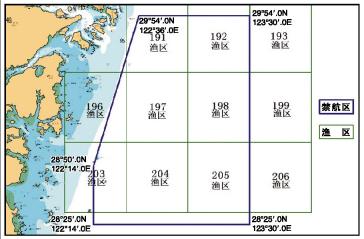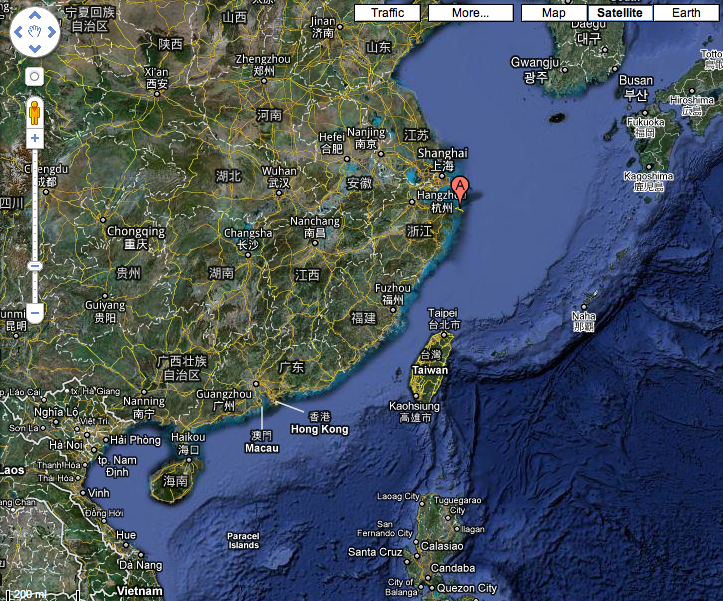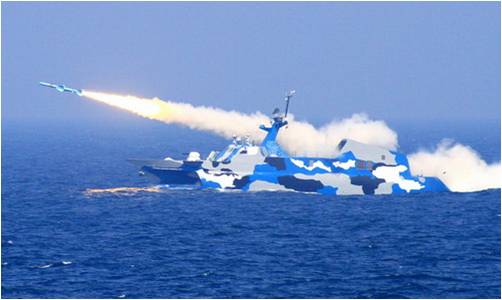Chinese Anti-Ship Cruise Missile Firing as Part of Combined Arms Anti-Carrier Exercises in East China Sea, 30 June-5 July
A new window into Chinese naval combined arms operations involving warships and fighter jets opened recently in the East China Sea. There the PLA carried out “live firing training” in a relatively small box-shaped area off Zhejiang Province between Zhoushan and Taizhou, within China’s Exclusive Economic Zone (EEZ) in the East China Sea from 30 June-5 July. The core theme of the combined arms exercises appears to have been demonstrating capabilities to attack surface ships, apparently a carrier strike group (CSG). Issues influencing the exact timing of the exercises likely include a desire to pressure the U.S. Navy not to hold exercises involving a carrier strike group with its South Korean counterpart in areas near China’s territorial waters and Exclusive Economic Zone.

Announced Zone of PLA “Live Fire Training” off Zhoushan, China in East China Sea, 30 June-5 July
A variety of coordinated maueuvers by East Sea Fleet surface ships and aircraft, involving anti-ship cruise missile launches by the surface ships, appear to have been at the heart of the exercises. In addition to squadrons of minesweepers, landing ships, submarine chasers and frigates from Fast Attack Craft Unit 91765 of the East Sea Fleet, as well as perhaps with support from Unit 92910, platforms involved reportedly included the Houbei Type 022 fast attack missile catamaran with its YJ-83 anti-ship cruise missiles. Chinese writings frequently advocate the employment of multi-axis “saturation” attacks against a carrier strike group, in which both ballistic missiles launched from land-based mobile transporter erector launchers (TELs) and cruise missiles launched from ships (e.g., the Houbei Type 022 fast attack missile catamaran) or submarines might be used in coordinated strikes designed to disable a carrier strike group’s defenses by overwhelming them. The PLA is therefore likely to test a variety of missiles from a variety of platforms. This offers three potential benefits: opportunities to (1) test its progress toward achieving some form of multi-axis combined-arms coordination, (2) demonstrate some level of existing capability, and (3) demonstrate a high level of resolve. It also offers potential insights into the PLA’s command and control capabilities, such as might be needed to execute a true combined arms attack–an achievement that many analysts have believed to be beyond the PLA’s ability.

Type 022 Houbei Missile Catamaran
Featuring in the Zhoushan exercises, reportedly, were stealthy Houbei class Type 2208 wave-piercing missile catamarans from Fast Attack Craft Unit 91765 of the East Sea Fleet. China’s 50+ hulls of this high-speed, stealthy, wave-piercing catamaran carry 8 YJ-83 anti-ship cruise missiles each. Regardless of their role in these particular exercises, these Fast Attack Craft are a vital part of China’s naval development.
For some time now, the PLA has been training to launch anti-ship cruise missiles (ASCMs) from multiple platforms. Many surface vessels and conventionally-powered submarines are taking ASCM delivery as their priority operational roles. China’s stealthy Houbei class Type 2208 wave-piercing catamaran fast attack missile craft, for instance, may even be envisioned as an expendable platform with no role other than to deliver ASCMs. As the U.S. Office of Naval Intelligence (ONI) emphasizes, “The PLA(N) has more than quadrupled the number of submarines capable of firing… ASCM[s], installed missiles with longer ranges and more sophisticated guidance packages on its surface combatants, [and] built over 50 high-speed ASCM carrying patrol craft….”
China’s surface fleet includes “well over 50 to date, with more under construction” of the 220-ton displacement Houbei Type 2208 missile catamaran. The high-speed (at least 36 knots, cited by some as exceeding 50 knots), wave-piercing, low observability (radar cross-section-reduced) catamaran, which is based on an Australian ferry design, is becoming a key component of the new PLAN (along with submarines). It might be given a mission to quickly destroy Taiwan’s surface force, if that fleet got out of port in the unfortunate (and increasingly unlikely) event of cross-Strait hostilities. The Houbei’s impressive anti-surface weapons system, consisting of 8 YJ-8A ASCMs fired from stern-mounted canisters, each with a range of approximately 50 nautical miles, would be highly effective in attacking surface warships in the waters around China, though the catamaran’s limited endurance (300 nautical miles) would not allow it to operate for extended periods at much greater distances. Other weapons systems include a Russian six-barrel AK-630 30 mm close-in weapons system on the front deck, and two four-cell tube launchers, perhaps for decoy and chaff, on the bow deck. The bridge may hold a small FLS-1 short-range surface-to-air missile launcher.
The 2208’s minimal in-water profile and high speeds could make it very difficult to hit with torpedoes. It would probably not be possible to use wake-homing torpedoes against Houbei catamarans. The torpedoes do not go fast enough, and lack the endurance to catch up with the Houbei if it is at speed. It also is unclear if the Houbei has sufficient displacement to satisfy whatever arming criteria a wake homer has. In any case, the U.S. does not have them. Chinese sources have suggested the use of small, fast craft to attack carrier strike groups—a possible anticipation of the Houbei missile catamaran’s envisioned operational role. This would represent modern, cruise missile-focused realization of swarming tactics, a traditional PLA Navy concept.
[Quotations regarding the number of Houbei Type 022 hulls and the YJ-8A ASCM range figures are from the following unclassified report: The People’s Liberation Army Navy: A Modern Navy with Chinese Characteristics (Suitland, Md.: Office of Naval Intelligence, July 2009), pp. 1, 20.].
Two of the best analyses to date of the Type 022 and its potential combat role include:
- Nan Li, “All at Sea: China’s Navy Develops Fast Attack Craft,” Jane’s Intelligence Review, (September 2009), pp. 2-3.
- Cdr. John Patch, U.S. Navy (Ret.), “A Thoroughbred Ship-Killer,” U.S. Naval Institute Proceedings, Vol. 136, No. 4 (April 2010), pp. 48-53.
As Cdr. Patch relates, the Type 022 “was first seen in Qiuxin Shipyard, Shanghai, in 2004…. The first hull measured 140 feet, with a very shallow five-foot draft. Maritime analysts view the rapid production of a large number of these radical new hulls at several different shipyards as a major event in PLAN shipbuilding.”
“Images of the Houbei platform strike even casual observers with the fact that it is essentially an ASCM platform,” Cdr. Patch adds. “Everything else on board simply supports that mission. This craft is a purebred ship-killer, perhaps even a carrier-killer. Alone, however, the Houbei is not particularly survivable, and may in fact be quite expendable. Speed is its greatest defense.”
According to Prof. Li, the Type 022 “is perhaps the primary platform to be used in the asymmetrical warfare that China could expect to fight in the medium term.” China’s near-seas active defense strategy, in place since the late-1980s, “requires naval capabilities to operate effectively in China’s three ‘near seas’ (the East China Sea, the South China Sea and the Yellow Sea) up to 400 nm offshore. The specific naval missions within this operational space include sea control for operations to invade Taiwan; securing China’s economic interests within and beyond its 200 nm exclusive economic zone; securing strategic sea lanes in times of war; and naval operations to resolve disputes over maritime territories in the East and South China Sea. The Type 022 is significantly more capable of fulfilling this mission than any of the PLAN’s other vessels.”
Regarding tactics, Prof. Li elaborates, the single (anti-ship) role Type 022 “fits well with the PLAN’s traditional ‘wolf pack’ operational approach, whereby multi-directional assaults on targets are conducted by groups of single-role ships, such as FACs [fast attack craft]. A newly developed and increasingly influential concept is that of the small battle group, whereby naval combatants with different functions but of similar manoeuvering speeds are combined in a single battle group. Theoretically, this exploits the potential complementarity of ships’ functions, from intelligence, surveillance and reconnaissance and command-and-control, to anti-ship, air defence, anti-submarine and electronic warfare.”
In terms of specific features, Prof. Li notes, “the Type 022 has a broad deck and low superstructure that helps to reduce roll, while the vessel’s tail dampers work to reduce wave excitation and enhance stability.”
Cdr. Patch observes further that “the catamaran hull is a small-waterplane-area-twin-hull (SWATH) design and has features similar to recent U.S. experimental high-speed vessels and the General Dynamics version of the Littoral Combat Ship (LCS). This design provides exceptional stability at high speeds, which is important when maintaining long-range command-and-control (C2) connectivity and firing ASCMs on the move.”
As for stealth characteristics, Prof. Li relates, the Type 022 has “features to reduce radar, visual, acoustic, and infrared signatures. Besides it relatively small size, the hull is sloped and the superstructure is kept low, and the vessel’s hatch covers and windows have jagged edges similar to those on a US F-117 stealth bomber. The hull carries camouflage paint, while its reconnaissance, telecommunications and navigational assets are reported to be largely passive to minimise electromagnetic emission. The Type 022 is also reportedly equipped with low-noise water-jet propellers and two-layered elastic shock-absorbing floating rafts for its power plant. Finally, the exhaust pipes… are deployed on the inner sides of the two pontoons to reduce infrared signature.”
Also noteworthy, in Cdr. Patch’s assessment, is “the Houbei’s surprisingly extensive (considering it is such a small combatant) data link connectivity for long-range coordination with aircraft, submarines, and other PLAN warships. All this points toward a craft designed for over-the-horizon targeting (OTHT) within a larger combat network.”
Prof. Li elaborates: “For sensors, the single large mast carries a 120 km-range sea and air search radar, and the top of the bridge features an electro-optic director that can conduct televisual, laser and infrared tracking of incoming targets within a 10 km to 20 km range. The vessel also features a data-link antenna between the two missile-launching houses, which may receive targeting information from the offboard sensors. To the extent the on-board sensors have limited range and can direct the CIWS against incoming targets, the long-range ASCMs may rely on the data-link to acquire targeting information for over-the-horizon strikes against surface targets. Finally, the bridge and the mast carry a variety of navigational, weather and communications radars and antennae, as well as electronic warfare devices.”
“Just a single C803 is a serious potential threat to a U.S. carrier or expeditionary strike group,” Cdr. Patch believes, “but Chinese naval tacticians almost certainly do not envision single-missile strikes against adversary capital ships.”
Yet even with China’s reliance on redundancy and numbers, Cdr. Patch stresses, “open-ocean OTHT is extremely challenging and only a potential future Chinese capability.” And “on her own, the Houbei has only marginal ability to find ASCM targets. Because of its limited range… especially at higher speeds, coordinated Houbei group operations in blue water would presumably require at-sea refueling (a current Chinese capability gap).” Moreover, “the likely frenetic underway tempo of activity of her small crew of 12 leaves little margin for organic target acquisition or situational awareness, even with increasingly automated weapon systems and sensors. …the vessel’s passive electromagnetic and electro-optical sensors… provide only line-of-sight targeting….”
Prof. Li concludes further that the Type 022 “suffers from various vulnerabilities, with its combat effectiveness limited by its small size, which significantly constrains its sea-worthiness and sustainability. Its stealthy design is also hampered by the use of aluminum rather than composite materials for hull construction, and [clutter] such as decoy/chaff launchers, rails and a searchlight on the bridge. Finally, the dependence of the long-range ASCMs on off-board sensors for targeting information also means their effectiveness may be reduced by jamming and other disruptions of the information chain.”
Despite these limitations, in Prof. Li’s assessment, the Type 022’s “relatively low cost of approximately USD14.3 million per unit but decent performance means the vessel is the only platform that has been mass produced in the PLAN’s post-2000 naval modernization drive. Current Jane’s estimates suggest China will build 81 type 022s to equip three 27-boat flotillas, one for each fleet, but this number could rise”; China has constructed roughly 60 hulls since 2004.
For now, Cdr. Patch concludes, “the Houbei herself remains unproven. Indeed, some of her ‘stealth’ features suggest they are more for visual effect than signature reduction. The final hull count of the Houbei (perhaps alongside a follow-on improved class) and operational deployments should help answer remaining questions about this mysterious new warship.”
Implications
Depending on their precise nature, and how Beijing explains them to the world, these exercises may provoke negative reactions. The exercises could seem very escalatory to some, especially as they appear designed specifically to target carrier strike group(s). They will undoubtedly be watched very closely in the U.S. and East Asian nations looking for signs of China’s intentions, particularly at a time when Beijing has apparently been quite accommodating of Pyongyang’s behavior. And there remains the issue of China’s ASBM and the state of its development. One thing is certain: consistent strategic dialogue between the U.S. and China is becoming more important than ever before.
http://www.chinadaily.com.cn/china/2010-06/29/content_10031224.htm
Li Xiaokun, “PLA set to hold Sea Drill,” Foreign and Military Affairs, China Daily, 29 June 2010.
BEIJING – The People’s Liberation Army (PLA) will launch a six-day, live ammunition drill starting on Wednesday in the East China Sea, a move that analysts said is in response to a joint exercise between the United States and Republic of Korea (ROK) navies in the Yellow Sea.
The PLA decision was issued on June 24 and posted on major Chinese websites on Monday, when the US-ROK drill was scheduled to start. The US and ROK earlier cited the Democratic People’s Republic of Korea (DPRK) as the target of their drill. A US nuclear-powered aircraft carrier is also reportedly scheduled to participate in the exercise not far off China’s coast.
But the ROK navy announced on Monday that their joint maneuver has been postponed to July.
According to the PLA announcement, all vessels will be prohibited from entering its designated exercise area from midnight to 6 pm, from June 30 to July 5.
“They must follow orders of the Chinese navy to ensure safety,” it said.
An officer of the Ministry of Defense said on Monday that the PLA’s planned drill is routine. But the Hong Kong-based Mingpao Daily News called the announcement a “rare move” to publicize a military drill days in advance.
Some analysts said the move is clearly related to the presence of aircraft carrier USS George Washington near China’s shores, which put major cities including Beijing and China’s coastlines under the US carrier’s combat scope.
“Though the Chinese government did not say anything about the drill, anybody with common sense on military strategy will bet that they are related,” said Shi Yinhong, a senior expert on US studies at Beijing-based Renmin University of China.
Foreign Ministry spokesman Qin Gang said earlier this month that Beijing is seriously concerned about the US-ROK joint exercise and is closely following the matter.
“Under current situations, relevant parties should exercise restraint and refrain from doing things that may escalate tensions and harm the interests of the countries in the region,” Qin said.
Ma Xiaotian, the PLA’s deputy chief of staff, said at an annual security conference in Singapore on June 5 that one of the major obstacles in China-US military relations is the “high-intensity surveillance of US warships and planes in the South China Sea and East China Sea.” US Defense Secretary Robert Gates was also present at the meeting.
The US and ROK said the joint exercise is targeted at the DPRK after the deadly sinking of an ROK warship in March, but it is “still extremely rare for a major power to send an aircraft carrier that close to another major power,” Shi said.
“Any large country has its bottom line for military vigilance and pride. The US-ROK drill has drawn angry response from the Chinese public and I think that is one reason behind its delay.”
Li Jie, a researcher with the Chinese navy’s military academy, said the US-ROK drill will not help ease tensions over the sinking of the ROK warship.
Pyongyang threatened on Monday to bolster its nuclear capability to cope with what it said is a hostile US policy and military threats.
Still, other analysts said the two latest drills are not related as the Chinese navy carried out a similar move last year.
Chen Hu, editor-in-chief of the World Military magazine affiliated to the Xinhua News Agency, said Beijing does not necessarily see the US-ROK exercise as a provocative act.
“Instead, the PLA can take the presence of the giant aircraft carrier fighting group as a ‘drill target’,” he said.
http://www.szcpost.com/2010/06/pla-issued-voyage-suspension-notice-for-live-firing-in-east-china-sea.html
Notice for suspension of fishing and voyage
PLA (People’s Liberation Army) issued a notice of voyage suspension on June 24 that a live firing training is going to be carried out in the area from Zhoushan to the east of Taizhou, within the NO. 191, NO.192, NO.196, NO.197, NO.198, NO.203, NO.204 and NO.205 fishing area at 0 o’clock to 18 o’clock every day from June 30, 2010 to July 5, 2010.
During the training, vessels of any kinds are forbidden to enter into the above mentioned area, and should obey the order of the naval vessel for safety concerns.
Shenzhen Post Elaine Contributes to the Story.
http://www.szcpost.com/2010/06/pla-issued-voyage-suspension-notice-for-live-firing-in-east-china-sea.html






































